Temples
Lin Fa Kung, Tai Hang
Temples introduction
Lin Fa Kung, Tai Hang
Lin Fa Kung (literally means Temple of Lotus) in Tai Hang was protected as Declared Monument in 2014. It was probably constructed in 1863 for the worship of Kwun Yum, the Goddess of Mercy. Its architecture is unique and rare in Hong Kong. Although it has undergone several renovations, the core structure of the temple is still be conserved. Lin Fa Kung has close connection with the Tai Hang Fire Dragon Dance, a traditional event which was inscribed onto the third national list of intangible cultural heritage in 2011.
Origin of the Temple
Kwun Yum is a Buddhist "bodhisattva" and people have a great respect for her mercy, compassion and salvation. Arising from a saying that Kwun Yum studied preaching on lotus blossoms, some Kwun Yum temples are also called Lin Fa Kung, meaning "Palace of Lotus Flower".
It was said that Kwun Yum had been appearing on a huge rock and villagers therefore built a temple on the rock to worship Kwun Yum. The rock is now commonly called the "Lotus Rock".
Another saying was that many refugees fled to Hong Kong from the southern part of China due to the Taiping Rebellion, quite a number of them were settled in Tai Hang. The village elders erected the temple to pacify the residents. Lin Fa Kung was built on a hill slope facing the sea with the nearby old Tai Hang village to its west. It was said that at high tide when sea water ran underneath the arches of the temple, the temple resembled a lotus in the water. However, due to reclamation, the temple is now situated in the maze of buildings.
Kwun Yum (also named as Guan Yin) - Goddess of Mercy
Kwun Yum or Kwun Sai Yum (觀世音) is known for centuries as a deity of sympathy, compassion and mercy. She is willing to hear the pleas of those who are suffering. Kwun Yum is a deity in both Buddhism and Taoism. Kwun Yum in the earlier times was a male divinity, but evolved to be a female deity in the Tang Dynasty. Arising from a saying that Kwun Yum studied Taoist teachings on lotus blossoms, some Kwun Yum Temples are also called Lin Fa Kung or Palace of Lotus Flower. Temples dedicated to Kwun Yum are often alternatively known as Shui Yuet Kung or Palace of Water and Moon (水月宮), which stands for quiet, peaceful and detached from the material world.
Architecture and Relics
Lin Fa Kung is a vernacular building with two halls. Its front hall is in half-octagonal shape with a double-eaves-tended roof and a verandah with western-style balustrades. Unlike most traditional temples where the main entrance is constructed in the middle of the facade, access to the temple is through the two staircases on the left and right side of the front hall. The rear hall is rectangular-shaped and consists of two levels, in between is where the Lotus Rock situated.
The temple houses rich historical relics including a stone made Kwun Yum altar (1885), offering table (1864), bell (1865), Choi Moon (1909), etc. In addition, altars dedicated to the worship of Tai Sui (Sixty Gods of Time), Kwun Yum and Wai Tor (Buddhist Temple Guardian) can be found on the upper levels of the rear hall. The ceiling of the front hall is in hexagonal-shaped and decorated with fresco of golden dragon, as if reflecting the close connection between the temple and Tai Hang Fire Dragon Dance.
Other Deities
Apart from Kwun Yum (Goddess of Mercy), the temple also houses Tai Sui (Sixty Gods of Time), Wai Tor (Buddhist Temple Guardian) and Yim Choi Sun (God of Wealth).
Festival Activities
There are four Kwun Yum Festivals every year and they fall on the 19th of the Second, Sixth, Ninth and Eleventh Lunar Month. Besides, the 26th of the First Lunar Month is the Kwun Yum Open Treasury and thousands of worshippers will queue-up for the event outside the temple every year. The Tai Hang Fire Dragon Dance, a traditional event being inscribed onto the third national list of intangible cultural heritage in 2011, will have the dragon's eye-dotting ceremony in the temple on the eve of Mid-Autumn Festival.
Renovations
This temple was renovated by the Chinese Temples Committee in 1986 and 2014. |

廟宇相片
Temples photo
廟宇地圖
Temples map
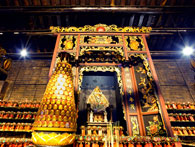
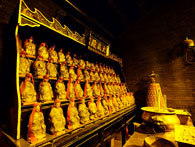
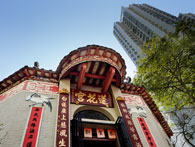
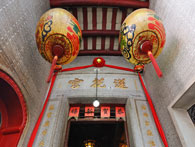
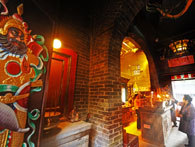
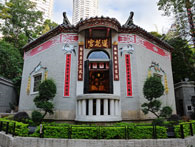
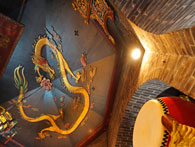
|
大坑蓮花宮
廟宇介紹
大坑蓮花宮
大坑蓮花宮,現為法定古蹟,位處銅鑼灣大坑區,建於同治二年(1863)左右,主祀觀音菩薩,建築風格獨特,全港獨一無二。本廟的前半部建於平台之上及以石柱支撐,廟的後半部則座落於巨石上,惟現時該巨石為外牆所擋,僅可於廟內見到部份。
建廟緣起
觀音是佛教的菩薩,以慈悲為懷、普渡眾生稱著,相傳觀音坐於蓮花上修行,故個別觀音廟又稱為蓮花宮。據稱觀音曾於廟內蓮花石上顯聖,為了紀念聖迹,村民於是立廟奉祀。另有考證指當時華南正值太平天國之亂,對廣東一帶影響甚深,大量難民南逃至香港及聚居大坑附近,長老為安定民心便建廟奉祀觀音。蓮花宮當年位於向海山坡下的巨石上及舊大坑村西面。有指每當潮水湧至廟下,蓮花宮便仿如水中蓮花,後因不斷的填海工程,令蓮花宮坐落於群廈之中。
觀音
源自印度,本為男相,自入中土後,漸轉化為端莊慈祥的女性,也是慈悲象徵,既有身披白衣、手持楊柳、淨瓶或魚籃,亦有千手千眼等法相。觀音為救渡眾生的大菩薩,相傳曾立誓渡眾生,透過慈悲心聆聽眾生苦難和祈求,每當眾生身受苦難,發聲發意求救,頌念觀音聖號,便可獲得救助。正因「觀其音聲,皆得解脫」,所以名為「觀世音菩薩」。觀音廟亦稱「蓮花宮」或「水月宮」,因觀音相傳坐在蓮花上修道;而「水」與「月」不單具有清靜及脫離塵俗之意,也比喻世事變幻無常,如幻非真
建築與文物
此廟可歸類為兩進式建築,但兩進之間不設天井,前殿建築呈半八角形寶塔狀,及設重檐攢尖屋頂,正面的小陽台設有西洋風格的欄杆。廟門設於左右兩側,與其他廟宇在中央設置廟門不同。主殿後部的建築為長方形,蓮花石亦位於此處,廟殿依蓮花石建,分成上下兩層,下層設石制神壇供奉觀音,上層設有太歲殿及木製觀音神樓,兩個樓層之間的平台則有韋馱殿。廟殿有立於道光與同治年間,雕工細緻的花崗石供枱(1864)、古鐘(1865)與石神壇(1885),及宣統年間的彩門(1909)。天花為六邊形,上有金龍與祥雲,前者神態活靈活現,似是呼應每年中秋期間舉辦的大坑舞火龍。而廟頂瓦脊則飾有象徵吉祥的寶珠、鰲魚及獅子等。
其他神祇
除觀音外,此廟亦供奉太歲、韋陀及陰財神。
廟宇誕日及特色活動
每年有四個觀音誕,分別為農曆的二月、六月、九月和十一月的十九日,廟內香火鼎盛,而農曆正月廿六的觀音開庫,更吸引近萬名善信參與借庫,輪候隊伍由蓮花宮伸延至蓮花宮東西街,全日人流不絕於途,場面非常熱鬧。此外,每年中秋節前後的舞火龍乃區內的年度盛事,火龍必在廟內點睛、拜神。插滿香枝的火龍在龍珠、天門及雲燈等引領下,穿梭大坑浣紗街及區內的大街小巷,街頭兩旁更掛滿彩燈及有鑼鼓表演助慶,再加上途人吶喊,情景熱鬧壯觀,這項承傳百年的傳統習俗,已於2011年被列為第三批國家級非物質文化遺產。
重修
此廟於一九八六及二零一四年由華人廟宇委員會重修
|








